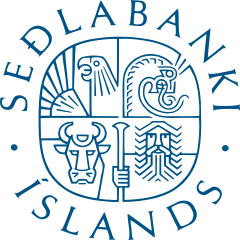Central Bank of Iceland
 | |
| Headquarters | Kalkofnsvegur 1, Reykjavík |
|---|---|
| Established | 7 April 1961 |
| Ownership | 100% state ownership[1] |
| Governor | Ásgeir Jónsson |
| Central bank of | Iceland |
| Currency | Icelandic króna ISK (ISO 4217) |
| Reserves | 4 790 million USD[1] |
| Preceded by | Landsbanki Íslands |
| Website | cb sedlabanki |
The Central Bank of Iceland (Icelandic: Seðlabanki Íslands) is the central bank or reserve bank of Iceland. It has served in this capacity since 1961, when it was created by an act of the Alþingi out of the central banking department of Landsbanki Íslands, which had the sole right of note issuance since 1927 and had conducted only limited monetary policy.
Seðlabanki Íslands is owned by the Icelandic government, and is administered by a governor and a seven-member supervisory board, elected by the country's parliament following each general election.[2] It has the sole right to issue notes and coins of Icelandic krónur and to manage the state's foreign currency reserves. The Central Bank Act of 1986 eliminated the ability of the Central Bank to regulate the interest rates of commercial banks and savings banks.
Though nominally independent, the Central Bank of Iceland was historically expected to follow the lead of the central government. In 2001, however, a floating exchange rate policy was introduced and since then the Central Bank has been empowered to adopt an inflation target and manage monetary policy so as to achieve price stability independent of the policies of the central government.
Governors[]
| # | Governor | Took office | Left office | Tenure length |
|---|---|---|---|---|
| 1 | 1961 | 1993 | 31–32 years | |
| 2 | 1961 | 1967 | 5–6 years | |
| 3 | 1961 | 1964 | 2–3 years | |
| 4 | 1966 | 1971 | 4–5 years | |
| 5 | 1967 | 1986 | 18–19 years | |
| 6 | 1971 | 1973 | 1–2 years | |
| 7 | 1974 | 1984 | 9–10 years | |
| 8 | Tómas Árnason | 1985 | 1993 | 7–8 years |
| 9 | Geir Hallgrímsson | 1986 | 1990 | 3–4 years |
| 10 | Birgir Ísleifur Gunnarsson | 1991 | 2005 | 13–14 years |
| 11 | Jón Sigurðsson | 1993 | 1994 | 0–1 years |
| 12 | Steingrímur Hermannsson | 1994 | 1998 | 3–4 years |
| 13 | Finnur Ingólfsson | 2000 | 2002 | 1–2 years |
| 14 | 2002 | 2003 | 0–1 years | |
| 15 | Jón Sigurðsson | 2003 | 2006 | 2–3 years |
| 16 | 1994 | 2009 | 14–15 years | |
| 17 | Davíð Oddsson | 2005 | 2009 | 3–4 years |
| 18 | 2006 | 2009 | 2–3 years | |
| 19 | Svein Harald Øygard | 2009 | 2009 | 0 years |
| 20 | Már Guðmundsson | 2009 | 2019 | 9–10 years |
| 21 | Ásgeir Jónsson | 2019 | Incumbent | 1–2 years |
Monetary reform[]
In 2015, after the 2008–2011 Icelandic financial crisis, the government of Iceland considered "a revolutionary monetary proposal" to abolish private money creation and to end to fractional-reserve banking.[3] Similar to the Swiss Sovereign Money Initiative, this plan would remove the power of money creation from the commercial banks and give it to the Central Bank of Iceland.[3]
See also[]
- 2008–2011 Icelandic financial crisis
- Economy of Iceland
- Financial Supervisory Authority
- Icelandic króna
- Glitnir
- Kaupthing Bank
- Landsbanki
References[]
- ^ Jump up to: a b https://d-nb.info/1138787981/34
- ^ "Leadership and organisation of the Central Bank of Iceland". www.sedlabanki.is. Archived from the original on 29 September 2011. Retrieved 8 May 2012.
- ^ Jump up to: a b Agence France-Presse, "Iceland looks at ending boom and bust with radical money plan", The Daily Telegraph, 31 March 2015 (page visited on 13 April 2018).
External links[]
- Official website (in English)
- Official website (in Icelandic)
Coordinates: 64°08′56″N 21°55′55″W / 64.14889°N 21.93194°W
- Central banks
- Banks of Iceland
- Banking in Iceland
- Banks established in 1961
- 1961 establishments in Iceland
- Government agencies of Iceland
